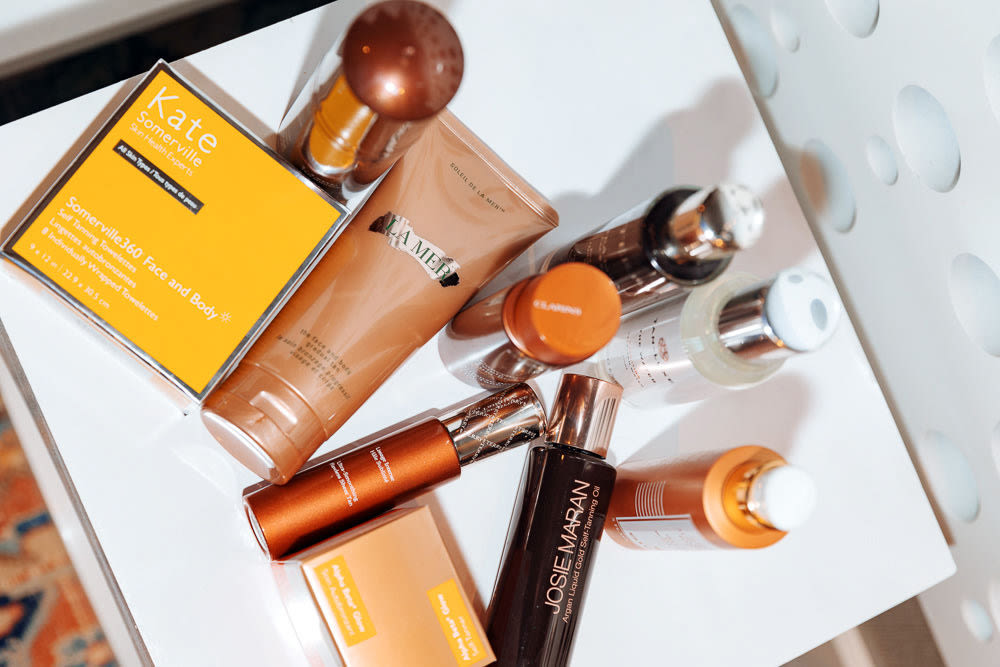We’ve been bottling sunshine since the '60s—that’s when the first self-tanner, Coppertone’s Quick Tan, hit the market. For me, the tell-tale yeasty smell of self-tanner is just as nostalgic as the gluey tang of Mod Podge, or thick, grandfatherly cigar smoke—it’s been part of my scent memories forever. Growing up on the beach, I was programmed to think a bronze tan equals health. I’ve tried professional spray tans, tan drops, tan foams, tan lotions… sometimes I apply them in a bikini to get self-tan lines. Whatever goop I use to get to my summer color, I know it’s a safer alternative to laying outside, slathered in tanning oil. So I use them—I use them all.
But, how do self-tanners even work? They start with a chemical called dihydroxyacetone, or DHA. DHA has remained the main active ingredient in self-tanners since Coppertone’s QT because it’s responsible for color. When DHA binds to amino acids in the skin, it causes the formation of melanoidins. Melanoidins, not to be confused with the natural pigment-causing cells melanin, provide a lasting bronze that won’t wash off in water—actually, the only way to get rid of a self-tan is to wait for the skin cells to shed. You can speed up the process through exfoliation, which is why I tend to to lay off acids when incorporating a self-tanner into my routine.
When I went to Georgia Louise Atelier for a facial with Autumn Henry, an aesthetician with over 15 years experience behind the magnifier, she blamed this skipped step for the smattering of clogged pores I get every time I commit to a summer glow. “Regular use of self-tanner is typically paired with a lack of exfoliation—you don’t want to take off the tan. But,” she explained, squeezing out the last of my blackheads, “this combination ultimately leads to a staining of the sebum and dead skin cells that congest our pores. I can always spot a fake tan,” Autumn said, “because the minute I turn on my mag lamp I see the tell-tale brown buildup littering the pores—think tiny freckles, but less cute.” The only way to get rid of them? Conveniently for Autumn, manual extractions from a licensed aesthetician. She tells a horrifying story of having to spend an hour-plus extracting a self-tan devotee’s stubborn “brownheads.” I leave with clear skin, and a vow to lay off the tanner… for at least the next week.
But maybe the damage of sunless tanning goes even deeper. Dr. Francesca Fusco, Assistant Clinical Professor of Dermatology at Mount Sinai in New York, explains that while DHA may stain pores, the usual cause of their dark appearance is due to free radicals, which are unstable atoms in the skin linked to acne and visible signs of aging. “When free radicals interact with other molecules in the body, the reactions are called oxidation. In the case of clogged pores, this can result in a darkening of the contents.” She adds, “In a similar way, oxidation is what causes cut fruit to turn brown as it is exposed to air.”
But it gets worse! Remember when I said self-tanner works by binding DHA to amino acids? In the process of fusing with those amino acids, DHA releases molecular compounds known as Amadori products. When you go in the sun, UV rays stimulate these Amadori products to create huge amounts of free radicals. As this study shows, the number of UV-generated free radicals in self-tanned skin can increase from 100-percent to 180-percent after 40 minutes of sun exposure. In other words, when you regularly use self-tanner, the oxidation happening on the surface of your skin increases by nearly double. That might mean more blackheads on acneic skin, and more oxidative stress to cause visible signs of aging.
OK, here’s the good news: that study was done with a solution of 20-percent DHA, and most self-tanning skincare products only include one to two-percent. More concentrated formulas (up to around 15-percent) often require dilution in moisturizer.
When it comes to free radicals, you can fight those with antioxidants, which combat any oxidizing effects. Most new self-tan skincare products already include them, but you can also mix any new generation tan drops into an antioxidant-rich moisturizer for an extra boost of support. And, since the risk of oxidation may be higher, wearing SPF with a self-tan sounds like a reasonable precaution.
Another way to avoid “brownheads” is to use your favorite acid exfoliant. Daily use tan formulations, like Tan Luxe’s Super Glow Serum, are meant for this purpose—the tan builds gradually and evenly, so you won’t get any weird patchy parts from exfoliation. If you apply your self-tan in the morning, save the acid for nighttime—or vice versa. Or maybe consider chucking the tanner, and whatever skewed beauty norms you’re holding onto, altogether! For days when corpse face gets the best of me, I’ll always have bronzer.
—Ali Oshinksy
Photo via ITG

